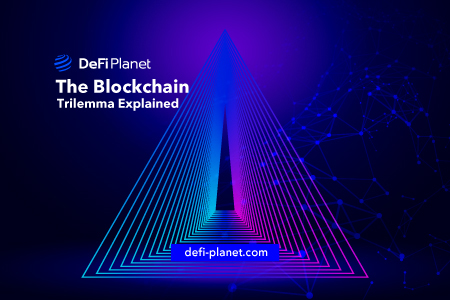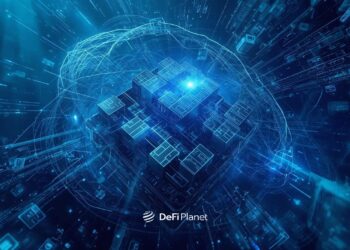Last updated on July 9th, 2023 at 06:57 pm
Blockchain is a distributed network of nodes designed to work together to achieve consensus. Because this technology is not centralized, it is impossible to verify its security, unlike custodial databases run by traditional payment companies such as Mastercard. For instance, Mastercard oversees its payment architecture and security level. In a decentralized structure like blockchain technology, it is critical to implement a custom security system to ensure resistance to external threats. Other elements of blockchain are its transparency and open access to people. Users can easily view the verified transactions in the network.
The blockchain trilemma focuses on three key elements that blockchains should possess; Decentralization, Security, and Scalability. It is common to see blockchains offering one or two of these elements. But there is hardly any blockchain that has successfully achieved all three.
For instance, the Ethereum network is decentralized and secure but lacks scalability. Users can carry out transactions with little or no fear of being hacked on the Ethereum chain. Crypto enthusiasts can be miners on the Ethereum 1.0 Proof-of-Work (PoW) network, or potential validators on the Proof-of-Stake (PoS) version, which is Ethereum 2.0 or Serenity. The network currently lacks a scalable solution. Congestion is the order of the day in the first version of the Ethereum network, and transaction fees are high.
New blockchains claim to solve the blockchain trilemma, but only a few have offered viable solutions. Some networks may be scalable, but they break down during the Token Generation Event (TGE) of a project on the platform.
The three elements of the blockchain trilemma are briefly explained below.
Security
Decentralization and security on a blockchain tend to go together, especially since a more decentralized network is likely to have a higher security level. With the distributed nature of the blockchain, it is highly secure. Multiple nodes are run effectively on the network, giving no control to a centralized authority. Blockchain does not possess a single point of failure because if several nodes are affected by an attack, the network will not be affected negatively. This does not mean that blockchain technology is not prone to hacks and attacks. When a hacker gains control of at least 51% of the network, they can manipulate it.
Blockchain security depends on the distributed nature of its nodes, preventing anyone from gaining control over it and altering the transaction and operations of the ecosystem.
Decentralization
One of the many reasons why people favour this technology is the element of decentralization. In a decentralized network, the operations of an ecosystem are not governed by a single authority. Transactions are not verified by a single person. Records are not held by a single node. If a node misbehaves, it does not affect the network negatively. The power lies in the hands of the community and the network is governed through a network of nodes scattered globally. Crypto enthusiasts adopted cryptocurrency, a digital asset built on blockchain because it allows them to enjoy financial freedom without the watching eyes of the government.
As mentioned earlier, decentralization and security are interrelated.
Scalability
Scalability seems to be the odd one out in this blockchain trilemma. More centralized networks are known to be faster compared to distributed types. Traditional payment systems, for example, tend to provide faster transaction speeds than crypto payment solutions. Streamlined networks offer a greater scalability level.
Scalability describes how much a network can grow without compromising transaction output and speed. Ethereum 1.0, for instance, was not always as congested as its current situation. As the network expanded and more developers built their decentralized apps and smart contracts on it, it started showing signs of congestion. Ethereum did not scale with the growth of its network.
Layer 2
Layer 2 is a network that works on top of underlying blockchain infrastructure to heighten its efficiency and scalability. An example of a popular Layer 2 solution is Polygon, designed to offer scaling infrastructure to networks like Ethereum. Bitcoin’s example of Layer 2 protocol is the Lightning Network. It is a technology that improves the transaction speed on the Bitcoin chain.
Layer 2 protocols like Polygon and Lightning Network have proven to be efficient ways of improving scalability on Proof of Work networks such as Ethereum and Bitcoin.
Nested Blockchains
A nested blockchain is a decentralized architecture that connects to the main blockchain to receive commands, then executes them. They are an example of a Layer 2 scaling solution.
Usually, nested blockchains have a parent-child relationship with the main blockchain. The parent chains send duties to the child chains and once they are executed, they are returned to the parent chain. An example of a nested blockchain that is built on top of the main chain is Ethereum’s OMG Plasma Network.
State Channels
State channels ensure that participants directly communicate with one another on the blockchain network, removing the need to wait for miners to verify a transaction. This type of layer 2 scaling solution sacrifices a bit of decentralization for scalability.
In a state channel, transactions are not verified by the nodes in layer 1. The network adjacent resource is sealed off in a special smart contract architecture. Once the transaction has ended, its final state and its elements are incorporated on the base layer.
Completed transactions are added to the distributed ledger, but the details of the transactions are kept private to the different participants involved. Examples of state channels are Ethereum’s Raiden Network, Celer, The Liquid Network, and Bitcoin Lightning.
Sidechains
Sidechains are smaller chains connected to the main blockchain through infrastructure similar to a bridge. This type of scaling solution uses an independent consensus mechanism from the main chain, allowing it to verify transactions. A sidechain is designed to validate transactions in record time. The duty of the main chain is to secure, resolve disputes, and ensure that public records are maintained.
Though sidechains may bear some similarities to state channels, they are different. The former is public unlike the latter. Transactions on sidechains are not private among participants. In a state channel, transaction details are kept private to the participants.
Secondly, a sidechain is not as easy to build as its counterpart. Developers have to build it from scratch, consuming time, effort, and money.
Thirdly, when a sidechain is compromised, it does not affect the functionality of the main chain, unlike state channels.
Has any crypto network solved the Blockchain Trilemma?
Algorand is a blockchain with an infrastructure that offers decentralization without sacrificing scalability. The network selects its validators randomly from token holders that meet the threshold.
Because of the element of randomness, no one knows what set of Validators the algorithm will choose next.
Using the randomness element offers decentralization and security to the Algorand network because no one can state for sure those that will belong to the next set of validators. The Pure Proof of Stake consensus mechanism used by Algorand solves the blockchain trilemma.
A lottery system is used on Algorand, which happens in a microsecond, making it highly scalable. Those token holders that win a ticket become one of the one thousand community members that can add blocks and verify transactions.
In Conclusion,
- Blockchain trilemma involves the security, decentralization, and scalability of a blockchain network.
- Some blockchains like Ethereum solve the security and decentralization elements of the blockchain trilemma while offering little or no scalable solutions.
- Decentralization and security are interrelated because a highly decentralized network is more difficult to compromise, unlike a centralized one.
- Layer 2 protocols are designed to improve the scalability of a network.
- Examples of layer 2 protocols are state channels, side chains, and nested blockchain.
- Algorand is a blockchain network with a peculiar way of solving the blockchain trilemma of security, decentralization, and scalability.
If you would like to read more articles like this, visit our Website. You can also follow DeFi Planet on Twitter, Facebook, Instagram, and LinkedIn.





















